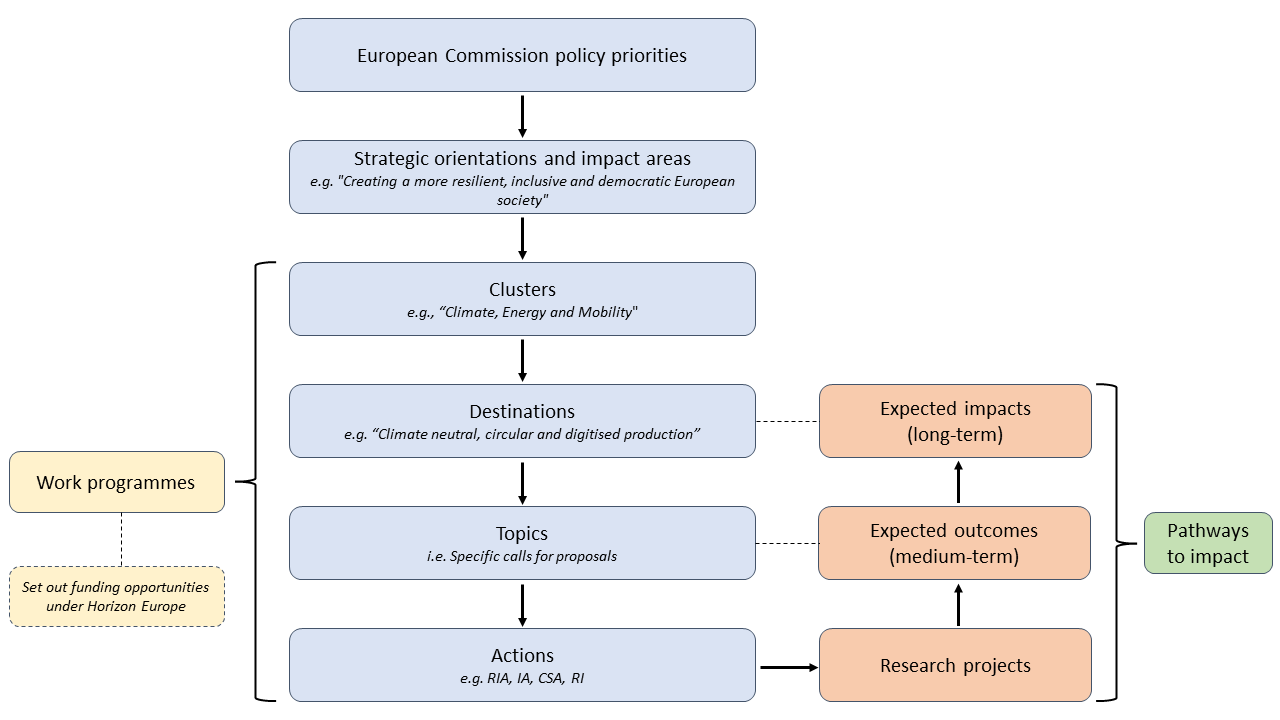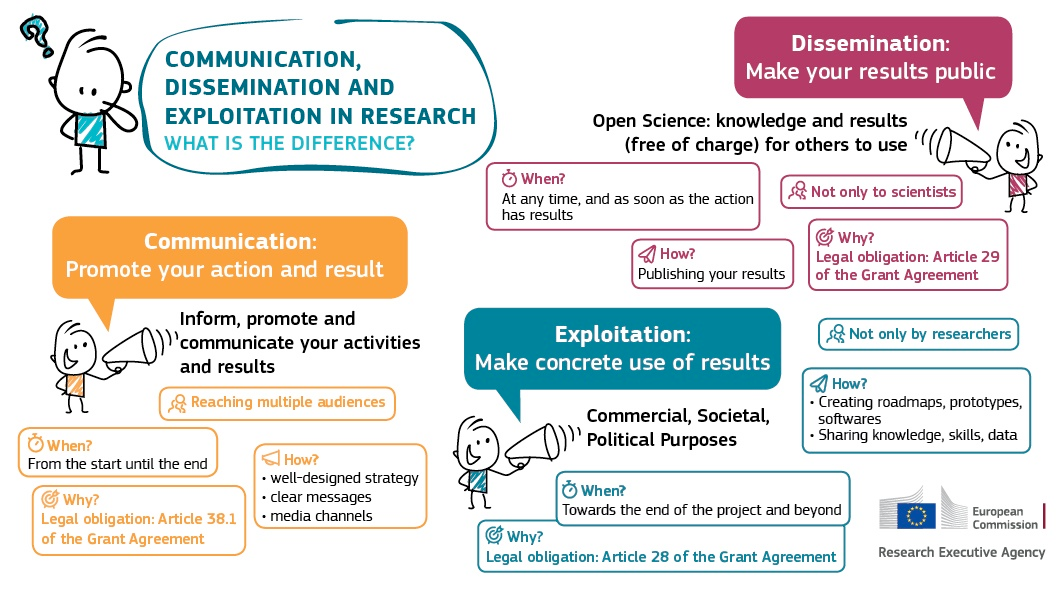Horizon Europe – The EU's major funding programme for research and innovation – is inherently impact driven, geared towards funding research that’s likely address societal challenges and the European Commission’s policy priorities.
Application structure and evaluation criteria
Your application will be evaluated and ranked against various (opens in a new window)award criteria. Part B of your application – the technical description – is broken up into three parts:
- Excellence
- Impact
- Quality and efficiency of the implementation.
The impact section itself, is made up of three sub-sections:
- 2.1 Project’s pathways towards impact
- 2.2 Measures to maximise impact - Dissemination, exploitation and communication
- 2.3 Summary canvas
In the impact section, you will be scored according to how well your application demonstrates:
- Credibility of the pathways to achieve the expected outcomes and impacts specified in the work programme, and the likely scale and significance of the contributions due to the project.
- Suitability and quality of the measures to maximise expected outcomes and impacts, as set out in the dissemination and exploitation plan, including communication activities.
Reviewers are given standard protocols for evaluating and scoring impact. But reviewers will likely come from different backgrounds and may interpret these protocols differently. Use the tips below to make sure your impact section convinces your reviewers, no matter what their background is.
7 tips for developing a competitive Horizon Europe impact plan
1. Remember the basics
The impact section in a Horizon Europe application isn’t fundamentally different from impact sections in other applications, so familiarise yourself with our general tips. For example, remember to use plain English, ensure stakeholder communication is two-way, describe your track record of creating impact, and use subheadings.
Make sure you start by filling in the UCD Impact Planning Canvas or the summary canvas in section 2.3 of your application, which share many similarities. This will help you think in a structured way about your stakeholders, pathways to impact, and measures of impact.
And remember, don’t confine impact to the impact section. Show you're serious about making a difference by embedding impact elsewhere in your application, like in the methodology, state of the art, activities, tasks, and allocated budget.
2. Align your impact goals with the Commission's
Take a moment to understand how Horizon Europe is structured, so that you can see where your proposal fits within the bigger picture, and you can map your impact goals to those outlined by the Commission in different documents.
At the very highest level, Horizon Europe legislation defines three broad types of impact, which are divided up into nine key impact pathways, so that the Commission can track and communicate the difference Horizon Europe is making around these nine storylines.
The (opens in a new window)Horizon Europe Strategic Plan 2021-2024 describes four key strategic orientations, supported by 15 impact areas. These 15 impact areas are structured by the six clusters that make up Horizon Europe’s second Pillar, “Global Challenges and European Industrial Competitiveness”.

Each cluster has an associated work programme, which is made up of “destinations” that articulate long-term expected impacts. In turn, destinations are supported by calls/topics that list expected medium-term outcomes.
This may all sound confusing. But the most important thing is to analyse the call topic in detail to assess how you can form a consortium that can address the expected outcomes, and read the relevant destination to understand the Commission’s higher-level, longer-term expected impacts.
Your pathway to impact should describe how your project's results will be disseminated, exploited and communicated in order to 1) address the expected outcomes in the topic and 2) contribute to the wider impacts outlined in the destination. Make these links explicit.
3. Set clear impact goals
The success of your impact section depends on how well you articulate these goals. It’s unlikely that your project can address every expected outcome and impact mentioned in the topic and destination, so carefully pick those that are most relevant (read the call document to find out how many you’re supposed to address).
Remember, make your impact goals SMART:
- Specific. Don’t be vague: spell out exactly who or what will benefit from your research (the reach) and how much (the significance).
- Measurable. For each impact goal, specify indicators that you can use to track progress. Make sure the data for your indicators are obtainable, and that they will give clear evidence of the reach and significance of the impact (and demonstrate how your research contributed). Consider providing baseline data, describing the current situation to contextualise your goal.
- Achievable. Your goals should be backed up with evidence to convince the reviewer that they’re feasible, and that you’re capable of creating impact within the stated budget. If you foresee any potential barriers, explain how you will overcome them. Some applicants like to summarise their barriers and mitigation strategies in a separate table or paragraph.
- Relevant. Your impact goals should align with those set out in related documents (see Tip 2 above).
- Time-bound. Articulate the various milestones on the pathway to impact. What exactly do you want to achieve by when?
Reviewers should be able to take in your impact goals at a glance. Make it as easy as possible for them. Some researchers choose to present a summary of their impact goals or impact pathways in a table (or even a well-designed infographic) at the top of the impact section. This can almost be a condensed version of the canvas in section 2.3. There are many approaches you can take, but these tables typically link each goal with stakeholders, indicators, timelines, and/or activities.
Then use the rest of sections 2.1 and 2.2 to go into detail. The reviewers don’t just want to know what the impacts are, but how they will be achieved. Describe your impact activities clearly. Why are they the best way of meeting your impact goals? The reviewers only want to see activities that make a significant and direct contribution to reaching the relevant outcomes and impacts, so avoid including any activity that is not explicitly linked to a goal.
4. Identify and involve key stakeholders
Meeting your impact goals will require connecting with different stakeholders in society. As a first step, map out the different groups, organisations and individuals who might be affected by your research, as well as those who have some influence over it.
If possible, work with colleagues on your stakeholder analysis. Collectively, you will paint a more thorough picture. And be as specific as possible: don’t just mention “government”, drill down into the specific departments, teams, or even individual contacts.
The summary canvas is a good place to start your stakeholder and public analysis. Professor Mark Reed at Fast Track Impact also offers a (opens in a new window)useful template.
Once you’ve identified and prioritised your stakeholders and publics, reach out to them. Listen to representatives from these interested or affected groups, and get their feedback on your plan. Your pathway to impact will be much stronger and more convincing if you co-develop it with your stakeholders. Don’t disingenuously tack this engagement on at the end of your application – your pathways to impact will not be credible.
5. Understand dissemination, exploitation and communication
In section 2.2, you need to describe your measures to maximise impact. These measures are categorised under three headings: dissemination, exploitation, and communication (D, E & C). Take the time to understand the difference between these terms:
- Communication is the broadest type of activity. It’s about sharing the project and results with wider audiences, informing society at large about research and its benefits.
- Dissemination means sharing your research results with society and the research community, telling people what you have achieved. It’s about making your results visible and facilitating uptake.
- Exploitation is the most specific. It’s about connecting your results with those who can use them for a particular purpose (like policymaking and commercialisation, for example).
Here's a useful summary graphic from the European Commission:

Crucially, make explicit links between your proposed D, E & C activities, your key stakeholders, and the impact goals you’ve outlined in 2.1. Again: never include an activity that isn’t linked to a goal. Make your actions specific, and ensure you have the relevant skills and expertise on the team to carry them out.
6. Demonstrate sustainability and scalability
Throughout the impact section, give evidence of sustainability. Convince the reviewers that you have planned for longevity; that the project will live on after the funding stops. Ensure your impact goals and measures reflect these longer time horizons.
Similarly, give evidence of scalability: how will you move from small- to larger-scale impact? Your activities and measures of impact should reflect this. Show the reviewers that you’re ambitious (but realistic) about the impact you can achieve, and that you intend to track the impact as it grows in scale.
7. Pay attention to intellectual property management
Where necessary, your application should address intellectual property, knowledge protection and regulatory issues. The Commission want to know that your project is commercially protected. Your proposal should include all the measures required to facilitate the commercial exploitation of the project.
Some reviewers also consider intellectual property rights a strong indicator of future impact. So make sure you have an IP strategy, if applicable, and show the reviewers that you take knowledge protection seriously. See the (opens in a new window)European IP Helpdesk for more information.